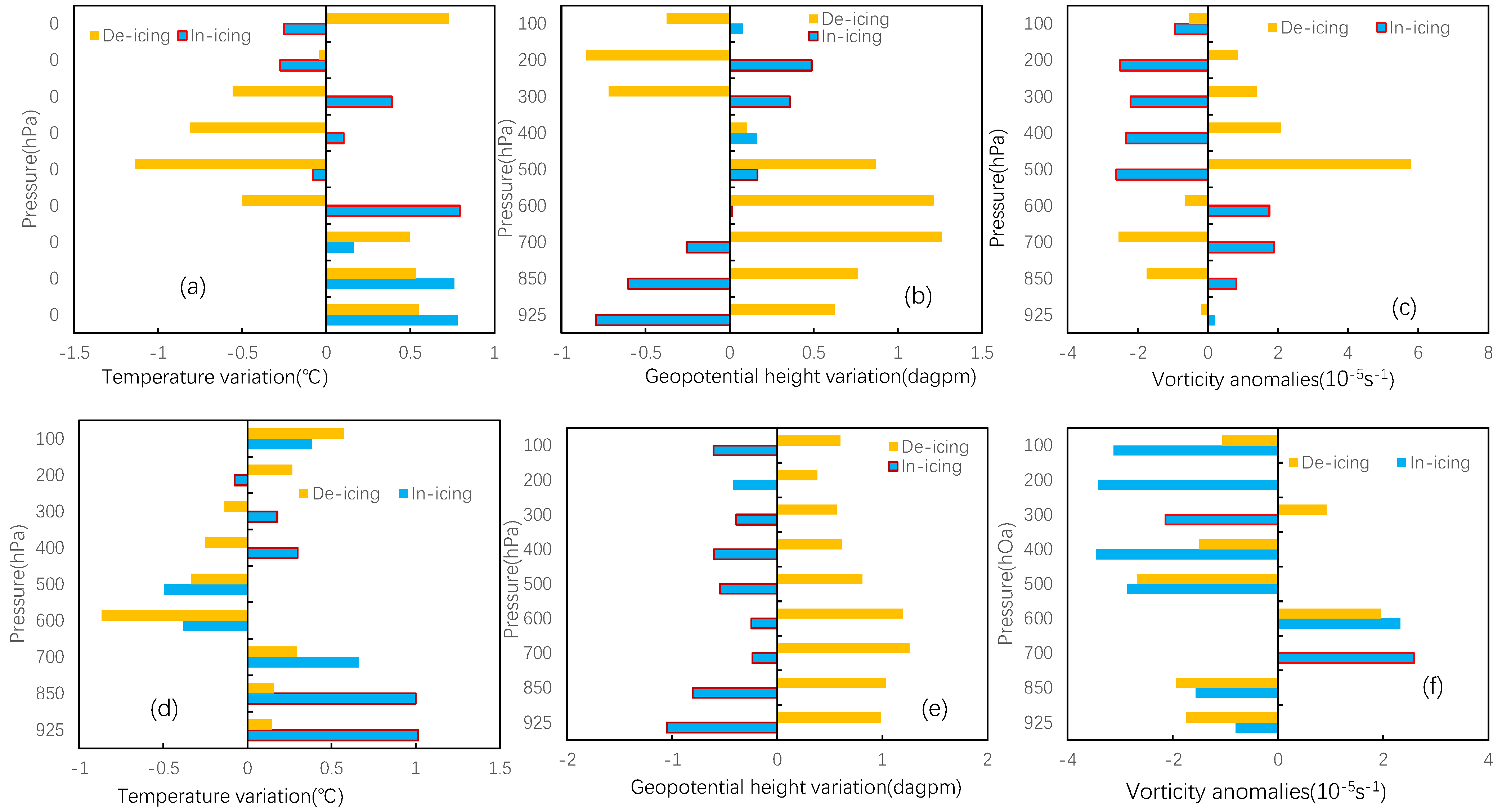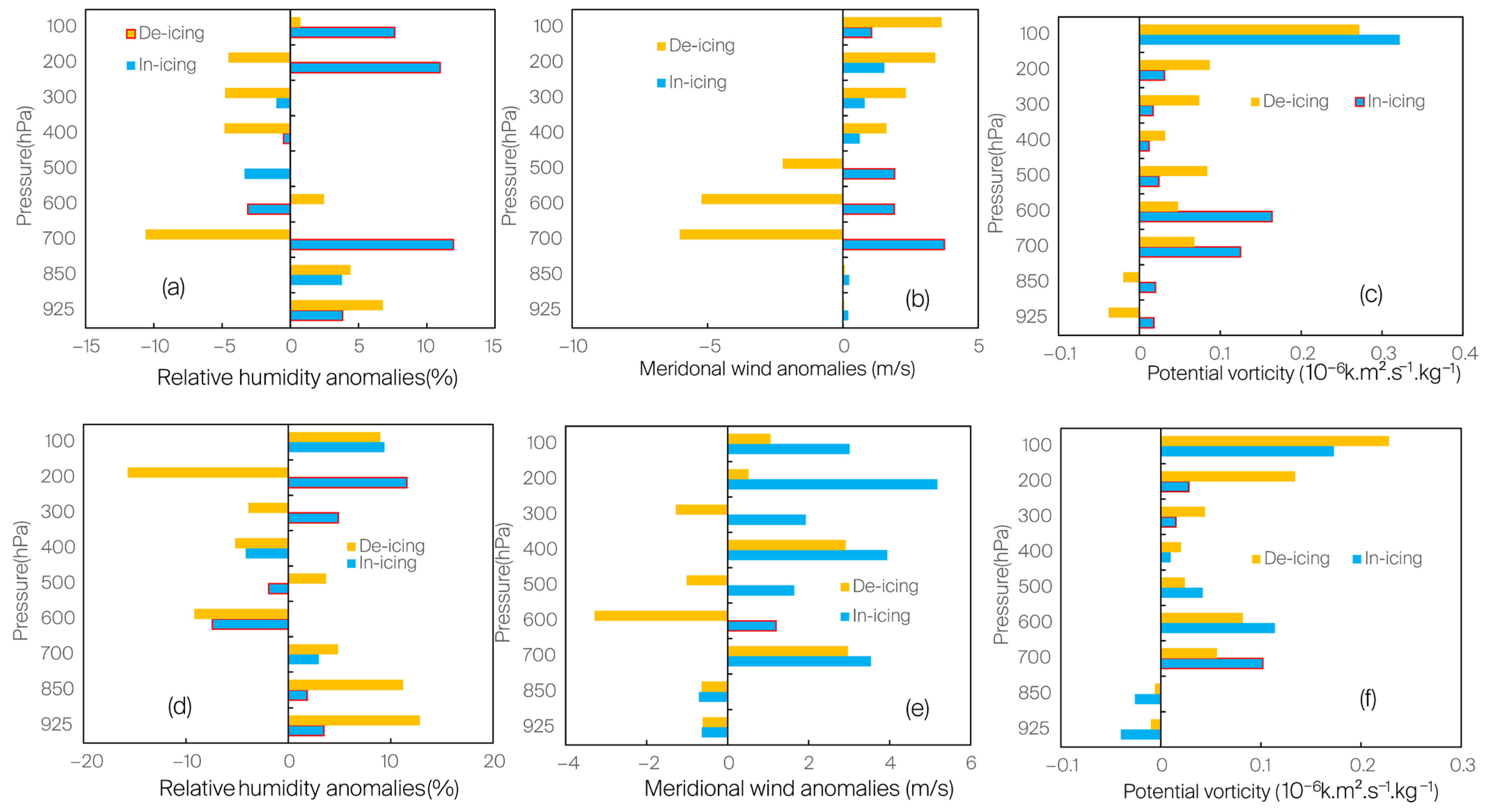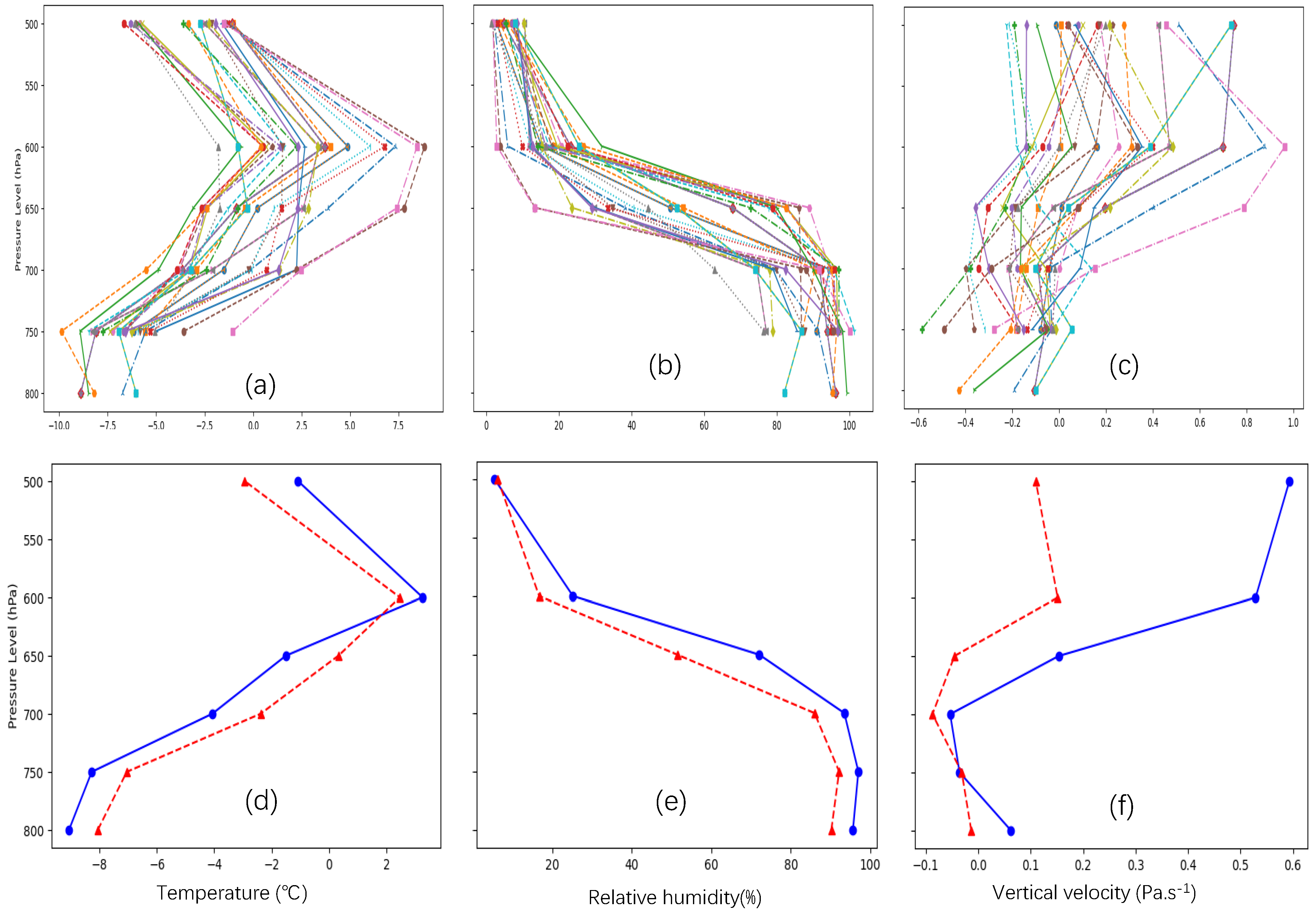Analysis of Weather Conditions and Synoptic Systems During Different Stages of Power Grid Icing in Northeastern Yunnan
Abstract
1. Introduction
2. Data and Methods
2.1. Datasets
2.2. Methods
3. Results
3.1. Brief Description of Icing in the Process
3.2. Freezing Type
3.3. Multilevel Element Analysis
3.4. Circulation Pattern of Icing
4. Summary and Discussion
Author Contributions
Funding
Institutional Review Board Statement
Informed Consent Statement
Data Availability Statement
Acknowledgments
Conflicts of Interest
References
- Farzaneh, M.A.; Volat, C.; Leblond, A. Atmospheric Icing of Power Networks; Springer: Berlin/Heidelberg, Germany, 2008. [Google Scholar]
- Zhou, Y.; Lv, J.; Gao, Z.; Zhou, L. Study on the macro and micro characteristics of large-scale freezing rain weather in Hubei Province. Torrential Rain Disasters 2024, 43, 458–468. (In Chinese) [Google Scholar]
- Wang, X.; Lu, Y.; Zhang, X.; Yang, L.; Wu, H. Research on risk forecast of transmission lines icing in northern Hebei Province. J. Arid. Meteorol. 2020, 38, 164–168. (In Chinese) [Google Scholar]
- Li, Q.; Meng, J.; Li, J.; Liu, Y.; Chang, Q.; Jiang, M.; Guo, D. Spatial distribution and division of wire icing thickness under different return periods in Shanxi Province. J. Arid Meteorol. 2022, 40, 156–165. (In Chinese) [Google Scholar]
- Zhao, L.; Ma, Q.; Yang, G.; Wang, X.; Zhao, L.; Yang, X.; Wu, H.; Wang, Z.; Kang, Z.; Mao, D. Disasters and its impact of a severe snow storm and freezing rain over southern China in January 2008. Clim. Environ. Res. 2008, 13, 556–566. (In Chinese) [Google Scholar]
- Niu, S.; Zhou, Y.; Jia, R.; Yang, J.; Lü, J.; Ke, Y.; Yang, Z. The microphysics of ice accumulation wires: Observations and simulations. Sci. China Earth Sci. 2012, 55, 428–431. [Google Scholar] [CrossRef]
- Wang, T.; Niu, S.; Lü, J.; Zhou, Y. Observational study on the supercooled fog droplet spectrum distribution and icing accumulation mechanism in Lushan, Southeast China. Adv. Atmos. Sci. 2019, 36, 29–40. (In Chinese) [Google Scholar] [CrossRef]
- McQueen, H.R.; Keith, H.C. The ice storm of January 7–10, 1956 over the northeastern United States. Mon. Weather Rev. 1956, 84, 35–45. [Google Scholar] [CrossRef]
- Wagner, J.A. Mean temperature from 1000 MB to 500 MB as a predictor of precipitation type. Bull. Am. Meteorol. Soc. 1957, 38, 584–590. [Google Scholar] [CrossRef]
- Zhao, S.; Sun, J. Multi-scale systems and conceptual model on freezing rain and snow storm over southern China during January–February 2008. Clim. Environ. Res. 2008, 13, 351–367. (In Chinese) [Google Scholar]
- Wu, H.; Zhang, J.; Zhao, Z. Spatial-temporal distribution characteristic elements causing ice disaster in transmission wires in Hebei province. J. Arid. Meteorol. 2017, 35, 991–997. (In Chinese) [Google Scholar]
- Ren, M.; Li, Z.; Wang, B.; Tan, Y.; Wang, S. Analysis on the causes of freezing stage characteristics in Guizhou in winter of 2021/2022. Arid Meteorol. 2023, 41, 744–752. (In Chinese) [Google Scholar]
- Chu, Y.; Guo, F.; Gao, F.; Hu, P.; Zheng, L.; Liu, Y.; Lu, Y. Comparative analysis of two different types of severe convective processes under the influence of cold vortex. J. Arid. Meteorol. 2023, 41, 279–289. (In Chinese) [Google Scholar] [CrossRef]
- Young, W.R. Freezing Precipitation in the Southeastern United States. Master’s Thesis, Texas A&M University, College Station, TX, USA, 1978. [Google Scholar]
- Huffman, G.J.; Norman, G.A. The supercooled warm rain process and the specification of freezing precipitation. Mon. Weather Rev. 1988, 117, 2172–2182. [Google Scholar] [CrossRef]
- Rauber, R.M.; Olthoff, L.S.; Ramamurthy, M.K.; Kunkle, K.E. The relative importance of warm rain and melting processes in freezing precipitation events. J. Appl. Meteorol. 2000, 39, 1185–1195. [Google Scholar] [CrossRef]
- Zhuang, W.; Zhang, H.; Zhao, H.; Wu, S.; Wan, M. Review of the research for powerline icing prediction. Adv. Meteorol. Sci. Technol. 2017, 7, 6–12+19. (In Chinese) [Google Scholar]
- You, Q.; Jia, X.; Qu, X.; Zhao, Z.; Wang, J.; Yang, L. Simulation and diagnosis of a continuous icing event on ultra-high voltage transmission lines in Hebei Province. Meteorol. Technol. 2023, 6, 888–897. (In Chinese) [Google Scholar]
- Yan, X.; Wu, Z.; Gu, S. Analyses on the space-time distribution characteristics and their influencing factors of freezing rain in Guizhou Province. Plateau Meteorol. 2009, 28, 694–701. (In Chinese) [Google Scholar]
- Kong, F.; Fang, J.; Qiao, F.; Wang, R. Temporal and spatial variation characteristics of intensity and frequency of hourly extreme precipitation in China from 1961 to 2013. Resour. Environ. Yangtze Basin 2019, 28, 3051–3067. (In Chinese) [Google Scholar]
- Tao, Y.; Li, H.; Liu, W. Characteristics of atmospheric stratification and cloud physics of different types of freezing rain over southern China. Plateau Meteorol. 2013, 32, 501–518. (In Chinese) [Google Scholar]
- Zong, Z.; Ma, J.; Zhang, H.; Hua, C. Analysis on the spatial-temporal characteristics of freezing rain in recent decades. Meteorology 2013, 39, 813–820. (In Chinese) [Google Scholar]
- Stewart, R.E.; Theriault, J.M.; Henson, W. On the characteristics of and processes producing winter precipitation types near 0 °C. Bull. Am. Meteorol. Soc. 2015, 96, 623–639. [Google Scholar] [CrossRef]
- Tao, S.Y.; Wei, J. Severe snow and freezing-rain in January 2008 in southern China. Clim. Environ. Res. 2008, 13, 337–350. (In Chinese) [Google Scholar]
- Coleman, H.; Marwitz, J. Thermodynamic and kinematic structure of a snowband and freezing rain event during STORM-FEST. Weather Forecast. 2022, 17, 27–46. [Google Scholar] [CrossRef]
- Bernstein, B.C. Regional and local influences on freezing drizzle, freezing rain, and ice pellet events. Weather. Forecast. 2000, 15, 485–508. [Google Scholar] [CrossRef]
- Gao, S.; Zhang, X.; Wang, J.; Du, X.; Deng, D. The environmental field and ensemble forecast method for the formation of freezing rain over Guizhou Province. Chin. J. Atmos. Sci. 2014, 38, 645–655. (In Chinese) [Google Scholar]
- Du, X.; Gao, S.; Peng, F. Study of the 2011 freezing rain and snow storm in Guizhou. Chin. J. Atmos. Sci. 2014, 38, 61–72. (In Chinese) [Google Scholar]
- Du, X.; Peng, F.; Wu, W. Distribution and cause on frequent freezing rain zone in Guizhou. Meteorol. Monogr. 2010, 36, 92–97. (In Chinese) [Google Scholar]
- Deng, D.; Gao, S.; Du, X.; Wu, W. A diagnostic study of freezing rain over Guizhou, China, in January 2011. Q. J. R. Meteorol. Soc. 2012, 138, 1233–1244. [Google Scholar] [CrossRef]
- Wang, Q.; Zhang, H.; Zong, L.; Su, H.; Yang, Y.; Gao, Z. Synoptic cause of a continuous conductor icing event on ultra-high-voltage transmission lines in northern Guangxi in 2015. J. Trop. Meteorol. 2021, 37, 579–589. (In Chinese) [Google Scholar]
- Chen, Y.; Zhou, Y.; Yang, S.; Ran, L.; Yan, L. Analysis of circulation characteristics and precipitation phase difference during an extreme freezing rain and snow weather event in Southwest China. Chin. J. Atmos. Sci. 2024, 48, 417–430. (In Chinese) [Google Scholar]
- Li, L.; Xi, X.; Li, Z.; Wang, X.; Weng, Q.; Li, Q.; Zhou, K.; Liu, Y.; Yao, J. Micro-meteorological analysis and prediction technology for transmission lines in micro-terrain environments. China Electr. Power 2023, 53, 76–83. (In Chinese) [Google Scholar]
- Liu, C.; Han, Y.; Wang, J.; Zhang, Z. Studies on statistics and formation mechanism of freezing rain. J. Catastrophol. 2015, 30, 219–222. (In Chinese) [Google Scholar]
- Yan, H.; Wang, L.; Zhu, Y.; Liang, H.; Huang, W. Cause Analyses of Severe Cold and Snowy Weather Formation in Yunnan in Early 2008. Plateau Meteorol. 2009, 28, 870–879. (In Chinese) [Google Scholar]
- Yan, H.; Kong, X.; Zi, Y.; Shu, K. Analysis of extreme cold event in 1924 February 2022 in Yunnan Province. Meteorol. Monogr. 2023, 49, 1029–1044. (In Chinese) [Google Scholar]
- Yan, H.; Li, G.; Yuan, Y.; Yao, Y. Atmospheric circulation difference between warm in early winter and cold in late winter of 2021/2022 over East Asia continent and its causes. Chin. J. Geophys. 2023, 66, 4026–4044. (In Chinese) [Google Scholar]
- Yan, H.; Wang, L.; Jin, Y.; Ma, S.; Li, W.; Wan, Y. Dominant patterns of winter temperature variation in Yunnan and key circulation factors affecting them. Plateau Meteorol. 2023, 42, 386–402. (In Chinese) [Google Scholar] [CrossRef]
- Liu, H.; Li, Z.; Tang, L.; Tang, J.; Su, T.; Yao, R. Circulation characteristics and causes of extreme low temperature and blizzard in Hunan in December 2018. Torrential Rain Disasters 2020, 39, 487–495. (In Chinese) [Google Scholar]
- Hersbach, H.; Bell, B.; Berrisford, P.; Hirahara, S.; Horányi, A.; Muñoz-Sabater, J.; Nicolas, J.; Peubey, C.; Radu, R.; Schepers, D.; et al. The ERA5 global reanalysis. Q. J. R. Meteorol. Soc. 2020, 146, 1999–2049. [Google Scholar] [CrossRef]
- Chen, B.; Yang, F.; Peng, F. Characteristics of the freezing disaster and its weather causes. J. Nat. Disasters 2020, 10, 88–95. (In Chinese) [Google Scholar]





| Ice Increase | Ice Maintenance | Ice Decrease | ||
|---|---|---|---|---|
| With precipitation | GG | 13 | 4 | 4 |
| GD | 2 | 2 | 17 | |
| DD | 0 | 0 | 0 | |
| DG | 15 | 10 | 6 | |
| without precipitation | GG | 15 | 1 | 1 |
| GD | 11 | 13 | 4 | |
| DD | 1 | 1 | 0 | |
| DG | 34 | 19 | 11 | |
Disclaimer/Publisher’s Note: The statements, opinions and data contained in all publications are solely those of the individual author(s) and contributor(s) and not of MDPI and/or the editor(s). MDPI and/or the editor(s) disclaim responsibility for any injury to people or property resulting from any ideas, methods, instructions or products referred to in the content. |
© 2025 by the authors. Licensee MDPI, Basel, Switzerland. This article is an open access article distributed under the terms and conditions of the Creative Commons Attribution (CC BY) license (https://creativecommons.org/licenses/by/4.0/).
Share and Cite
Wang, H.; Zheng, R.; Luo, G.; Tan, G. Analysis of Weather Conditions and Synoptic Systems During Different Stages of Power Grid Icing in Northeastern Yunnan. Atmosphere 2025, 16, 884. https://doi.org/10.3390/atmos16070884
Wang H, Zheng R, Luo G, Tan G. Analysis of Weather Conditions and Synoptic Systems During Different Stages of Power Grid Icing in Northeastern Yunnan. Atmosphere. 2025; 16(7):884. https://doi.org/10.3390/atmos16070884
Chicago/Turabian StyleWang, Hongwu, Ruidong Zheng, Gang Luo, and Guirong Tan. 2025. "Analysis of Weather Conditions and Synoptic Systems During Different Stages of Power Grid Icing in Northeastern Yunnan" Atmosphere 16, no. 7: 884. https://doi.org/10.3390/atmos16070884
APA StyleWang, H., Zheng, R., Luo, G., & Tan, G. (2025). Analysis of Weather Conditions and Synoptic Systems During Different Stages of Power Grid Icing in Northeastern Yunnan. Atmosphere, 16(7), 884. https://doi.org/10.3390/atmos16070884






